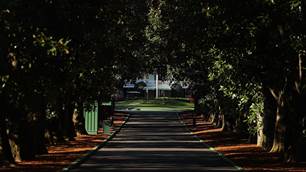If you’ve ever wondered whether golf is more a mental or physical pursuit then wonder no more.
The answer to this vexed question, one that has spawned entire books, can be found in the simplest and most confounding three letter word in the world: par.
The notion of par makes golfers lose their minds. It forces even the very best to sometimes hit shots that are patently absurd.
It stimulates fear and panic and creates expectations which cloud judgement.
Yes folks, the construct of par is proof positive that golf is almost 100 percent a game of the mind.
There is, of course, a physical element, one which dictates to a degree what level of golf you play.
"Peter Thomson once called The Masters the greatest con job in sport but – while it’s a contender – the construct of par has it covered."
But the one constant for every golfer, from the gifted to the duffer, is the mental and emotional capacity to deal with the questions the game asks.
And in this regard par – or more precisely the concept of par – is the very embodiment of the tricks the game plays on us.
It sets a benchmark that does not in reality exist then has us fool ourselves into believing that yard stick is somehow set in stone.
Peter Thomson once called The Masters the greatest con job in sport but – while it’s a contender – the construct of par has it covered.
Almost every golf course has a hole or two which fit the ‘half-par’ category and they are generally the most interesting to play.
Augusta National’s 13th and the Road Hole 17th on the Old Course at St Andrews are excellent examples of the concept, both demanding two good to excellent shots to find the green with severe penalty for failing the test.
But at Augusta the par is five and at St Andrews it is four (although it was five many decades ago) and that plays havoc with decision making.
At Augusta the second shot presents an opportunity, the chance to do something spectacular and make a move up the leaderboard with an ‘eagle’ three.
At St Andrews the second shot feels more like a burden, the pressure to find the green and not lose ground on the field upper most in mind.
In reality, the two holes are not dissimilar (as their scoring averages for The Masters and Open will attest) but in the mind of the player one is ‘easy’ and the other is ‘hard’. All because of ‘par’.
There is nothing wrong with this fallacy, of course, and we as golfers go along with it willingly.
Like the marketing that tells us we can buy a better game with this club or that; we know deep down the only path to genuine improvement is lessons and practise but we buy the shiny new driver anyway.
In that same way we buy into the notion of par and in that same way it adds an element of interest to the game.
But don’t be fooled by it. In the end it is just an arbitrary number written on a scorecard and to let it dictate what shot you play next is to fall victim to its wily charms.
Related Articles

Australian Open winner will receive invite to The Masters

Tough Open start doesn't deter Croker from relishing life in the big league













